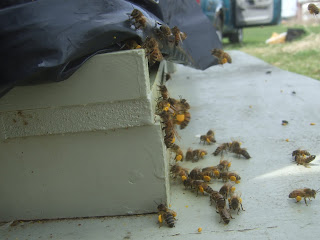 It was a lovely sight to see when arriving at the bee yard. Gold. Large gold lumps on dozens of workers' legs.
It was a lovely sight to see when arriving at the bee yard. Gold. Large gold lumps on dozens of workers' legs.Finally we had a warm sunny day with temperatures around +15 Celsius and the bees were happy to be out flying.
The flowers were blooming and offering pollen and the bees seemed to know exactly where to look for it.
The line-ups outside the hive were a pleasure to watch and photograph. I still have my entrance reducers in place. I'll probably be removing them next week when I do my Formic Acid treatment.
 Most had packed their pollen well above their basket level. They were waddling into the hive under the weight. I don't think they minded at all.
Most had packed their pollen well above their basket level. They were waddling into the hive under the weight. I don't think they minded at all.All four hives were active bringing in the same yellow coloured pollen.
Hive #2 has opted this year to come and go from the top entrance. Typical with this hive which insists on doing everything differently than the other hives.
This just goes to show that not all hives behave the same way.
At our last bee club meeting I met several new wanna-bee beekeepers. It was very exciting to see so many at our meeting this year.
At this visit one of them, Janice, came to see our hives opened and to get some first time hands on the bees. I'm so proud of the bees' behaviour--calm and gentle, as always and no smoke needed.
Hive #1 had not finished their second baggie/Fumigilin treatment. They had eaten most of the AFB powder but aren't due for more until next week.
Hive #2 hadn't finished their first baggie/Fumigilin. This is the hive that does things differently and sometimes makes me resort to prayer. They had brown poop outside the hive in winter so I had a concern they may be battling Nosema and all winter I feared they were dead. But they keep surprising me.
 Hive #3 is very busy and they had the most workers out getting the pollen--the photos are of this hive. They had finished their baggie/Fumigilin so we gave them their second and final baggie. Once that's done I'll switch to the hive top feeder. They had made good progress eating their AFB powder.
Hive #3 is very busy and they had the most workers out getting the pollen--the photos are of this hive. They had finished their baggie/Fumigilin so we gave them their second and final baggie. Once that's done I'll switch to the hive top feeder. They had made good progress eating their AFB powder.Hive #4 had finished their second baggie/Fumigilin so their treatment is done. They still had patties and AFB powder to finish. I removed one rim spacer so they had less room (hives 3 and 4 are very keen to build comb if there's extra space). Then I added the hive top feeder with syrup.
Wraps are also still on all hives. I'll look at taking them off in the next week or two when temperatures are more stable and not so cold at night.
























